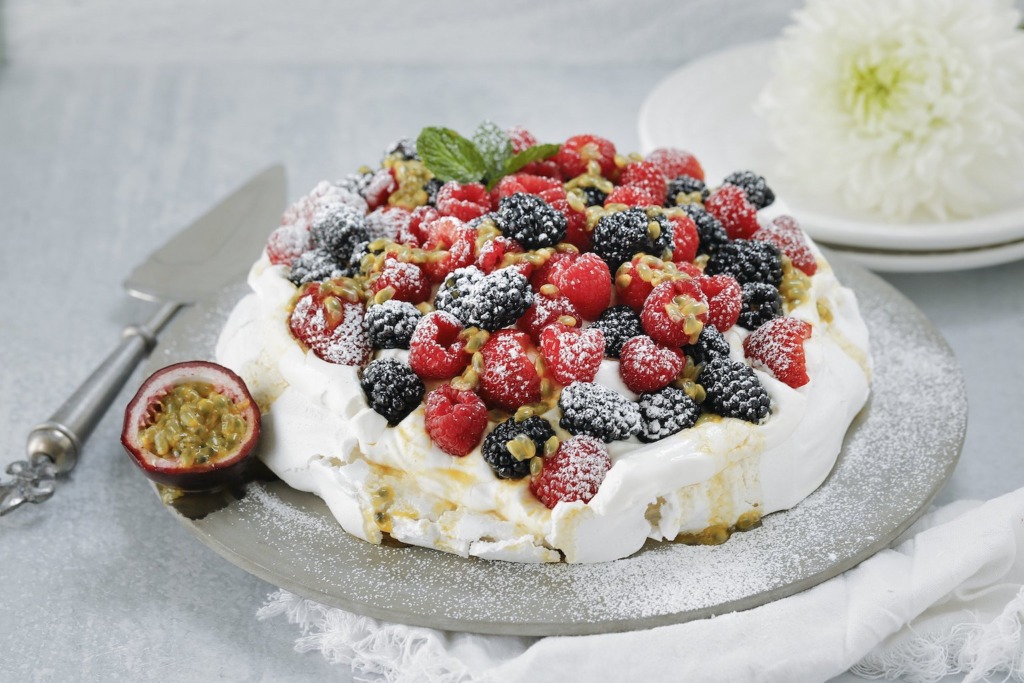When I think of the color of Easter, it’s not the season’s ubiquitous pastels that come to mind. It’s white.
White represents purity, truth, joy, good, triumph and light. It evokes the Resurrection, and thus is the liturgical color of Easter time.
This Easter, I’m trying a recipe for pavlova. Named for the famous Russian ballerina Anna Pavlova, the dessert’s origin is Oceania, specifically New Zealand and Australia. Pavlova is a dream, and there are not many recipes that present white in such extraordinary and tasteful fashion.
Pavlova is distinguished by a white meringue base that is crisp on the outside and marshmallowy soft on the interior. The base is filled with whipped cream and topped with an assortment of fresh fruit. A perfect centerpiece for any Easter brunch or dinner, pavlova is gluten free and not overly sweet.
Have patience and a delicate touch when making pavlova. If you follow the recipe directions precisely, you will reward your Easter guests with a show-stopping treat.
Here are few tips for a successful pavlova.
Use superfine sugar for the meringue. You can find it in most grocery stores or make it by whirling granulated sugar in a blender or food processor for several seconds.
Take your time whipping the meringue on medium speed. If you whip the meringue quickly, it will become too dry when baked. Begin by whipping the egg whites, cream of tartar and pinch of salt until frothy. Then start adding the superfine sugar, one tablespoon at a time, and continue beating on medium until all the sugar is dissolved and the whites are glossy and softly stiff.
Don’t skip any ingredients. The cream of tartar helps to stabilize the meringue, and the cornstarch makes the shell interior soft and fluffy.
Don’t be tempted to raise the heat on the oven to bake the meringue more quickly. It has the potential to turn golden or brown at a higher temperature.
After the meringue bakes for 90 minutes at 200 F, turn the oven off, and don’t open the door. Leave the shell in the oven until completely cool, about 3 hours or more.
A few cracks may appear on the shell; don’t worry. Cracks add to pavlova’s rustic appeal. However, be careful when moving the meringue shell from the baking sheet to a serving platter. I found it useful to use two large spatulas.
Even if your pavlova cracks and separates, carry on with the recipe. My first pavlova shell split in half. I still assembled the dessert, presenting it to my guests as “deconstructed pavlova.” Everyone gobbled it up!
Go slowly and use a light hand when filling the shell with whipped cream and fruit.
You can use just about any fresh fruit for pavlova. Kiwi, mango, orange segments, even figs are good choices. This recipe uses passion fruit, which is widely available in Australia. Passion fruit adds a tart, flowery flavor that is a perfect complement to sweet berries.
The meringue shell can be made up to two days ahead. Cover it completely with plastic wrap and store at room temperature. Prepare the fruit and make the whipped cream ahead of time and refrigerate both for up to eight hours. Assemble the pavlova just before serving.
An assembled pavlova does not keep well. Offer seconds if there is still some left after everyone is served.
PAVLOVA
Prep time: 45 minutes
Bake time: 90 minutes
Cool time: 3 hours
Assembly: 15 minutes
Servings: 8
Ingredients
For the meringue shell:
Whites from 5 large eggs at room temperature (Reserve the yolks for another use.)
1 teaspoon cream of tartar
Pinch of salt
1 cup superfine sugar
1 1/2 teaspoons cornstarch
For the whipped cream:
2 cups heavy cream
1/4 cup confectioners’ sugar
1 teaspoon vanilla
For the top:
2-3 pints fresh berries
3 passion fruits cut in half (optional)
2 tablespoons confectioners’ sugar (optional)
Instructions
Set oven to 300 F.
Use an 8-inch salad plate to draw a circle on a sheet of parchment paper. Turn over the paper, put it on a sheet pan and set aside.
Place egg whites in a large mixing bowl. Add the cream of tartar and pinch of salt to the bowl. Mix on medium speed until the whites are frothy and beginning to turn opaque. Start sprinkling in the superfine sugar one tablespoon at a time until all the sugar in incorporated and the meringue looks glossy white. This will take about 15 minutes.
Turn the mixer to high and beat for another 1 to 2 minutes. The meringue should form soft, stiff peaks. Make sure the sugar is dissolved by rubbing a small amount of meringue between your fingers. If it feels gritty, beat the whites a bit longer.
Turn off the mixer, sift and then gently fold the cornstarch into the meringue.
Spoon the meringue onto the prepared parchment paper. Use a flat spatula to spread it using the traced circle as a guide. Make a well in the center of the meringue and bring up the sides a bit.
Place the sheet pan in the oven and immediately turn down the heat to 200 F.
Bake the meringue for 90 minutes at 200 F.
When the meringue is done, turn the oven off but don’t open the door. Let the meringue cool in the oven for at least 3 hours. The meringue can stay in the oven overnight.
Prepare the whipped cream. Place heavy cream, confectioners’ sugar and vanilla in a mixing bowl. Beat on high until soft peaks form, about 2 minutes.
Using two large spatulas, carefully transfer the meringue shell from the baking sheet to a serving plate or cake stand.
Fill the center of the shell with the whipped cream. Arrange berries on top and drizzle on the pulp and seeds of the passion fruit. Sift a little confectioners’ sugar over the pavlova and serve immediately.
– – –
Follow Wiechec on Twitter: @nancywiechec

